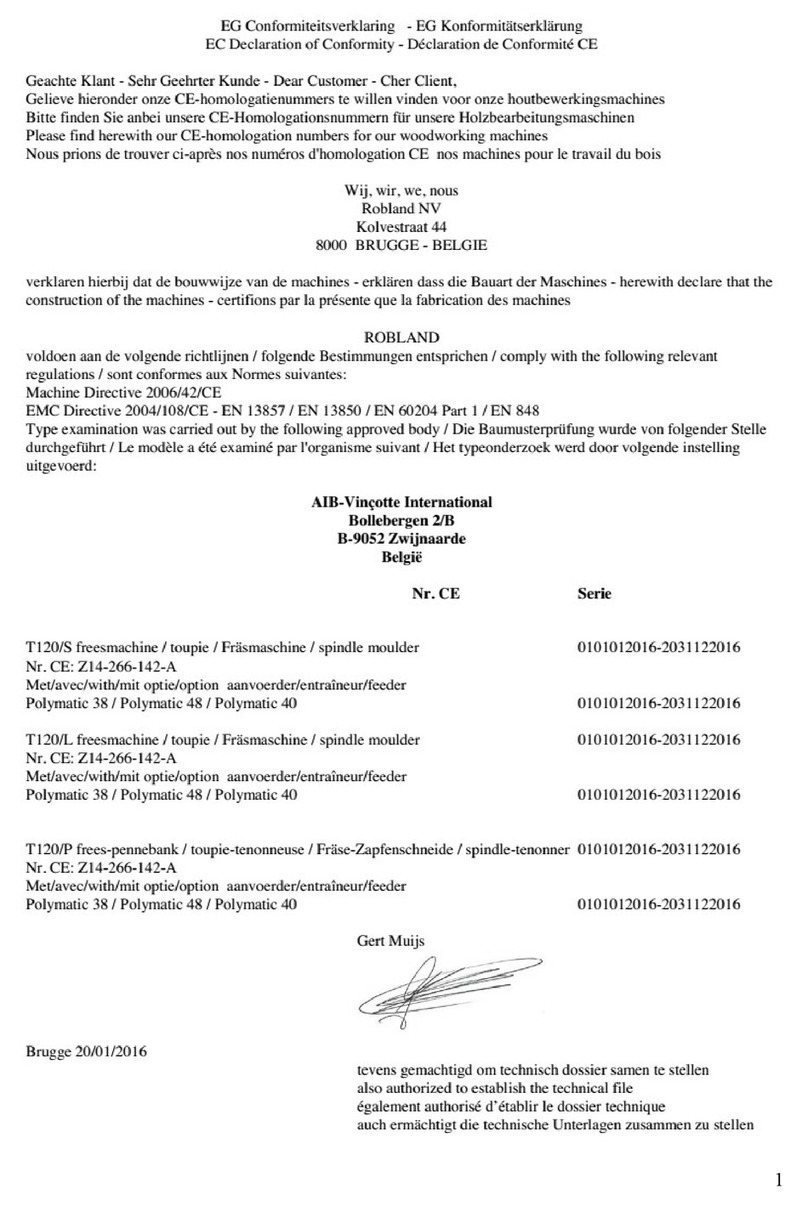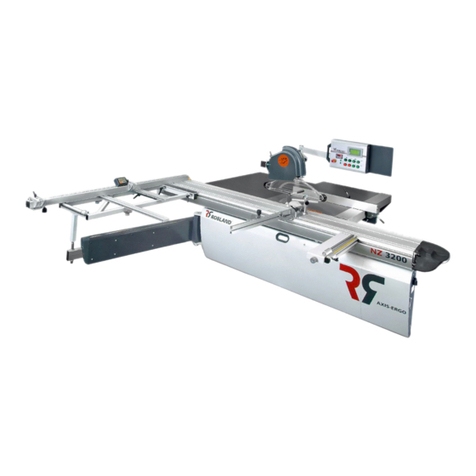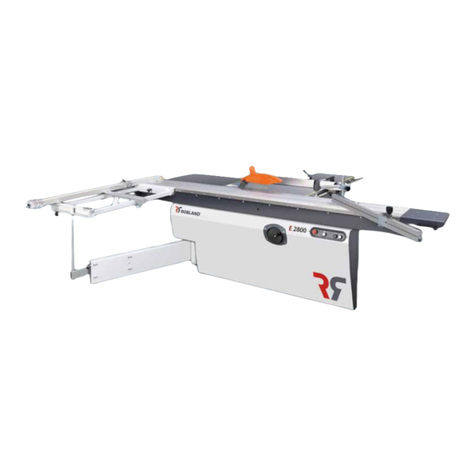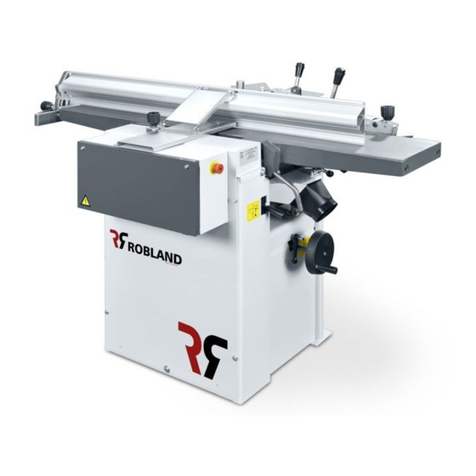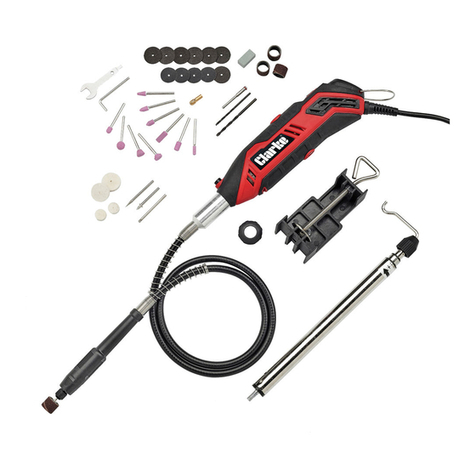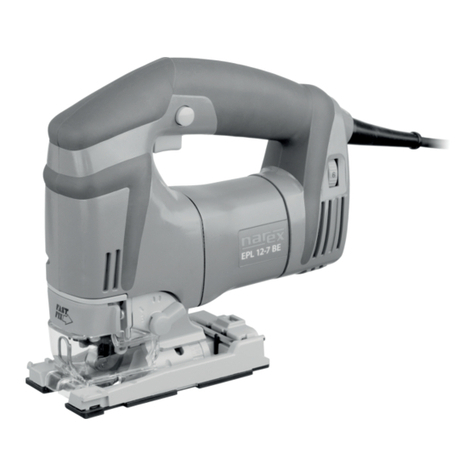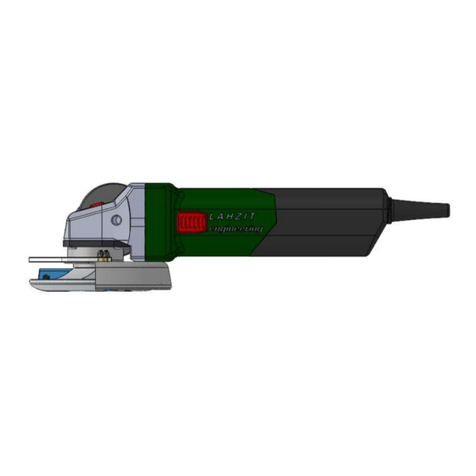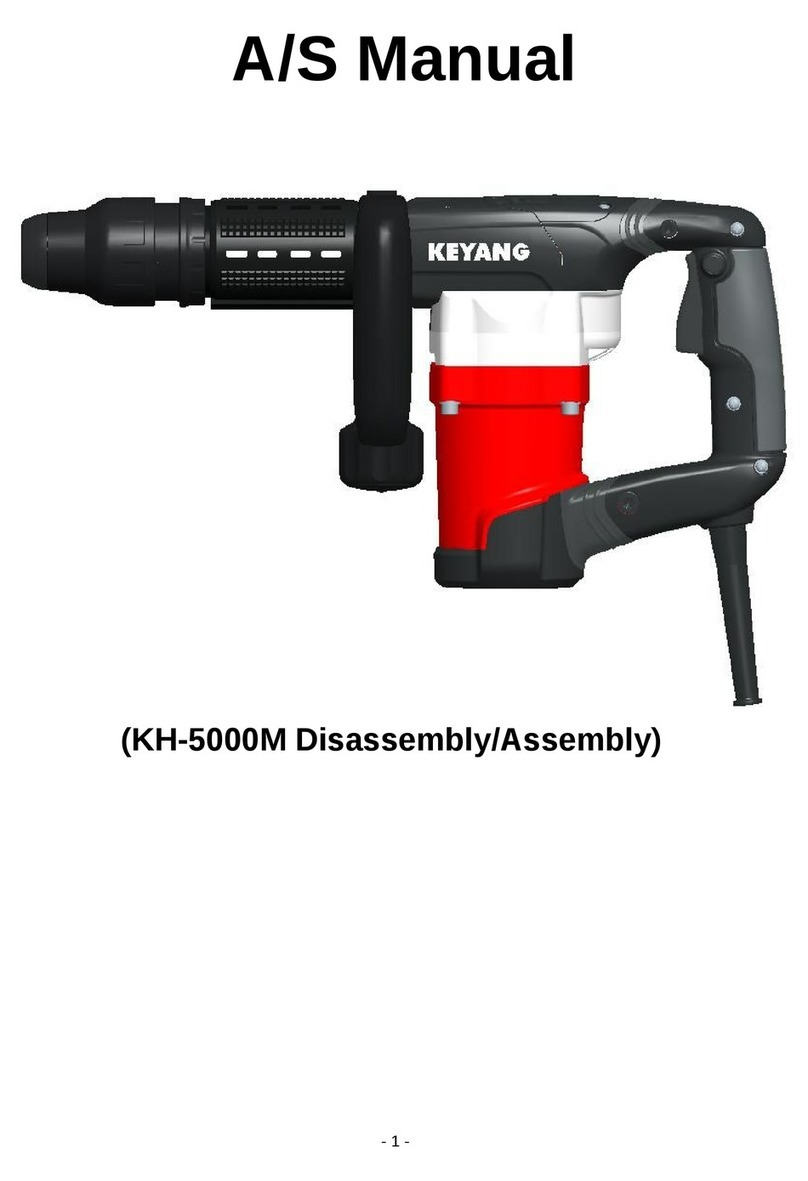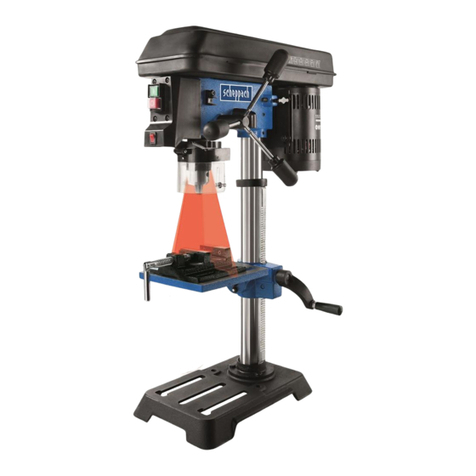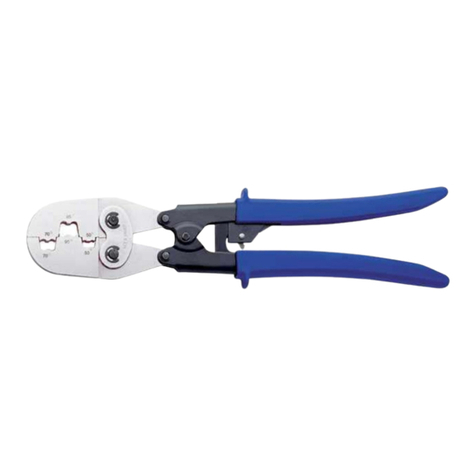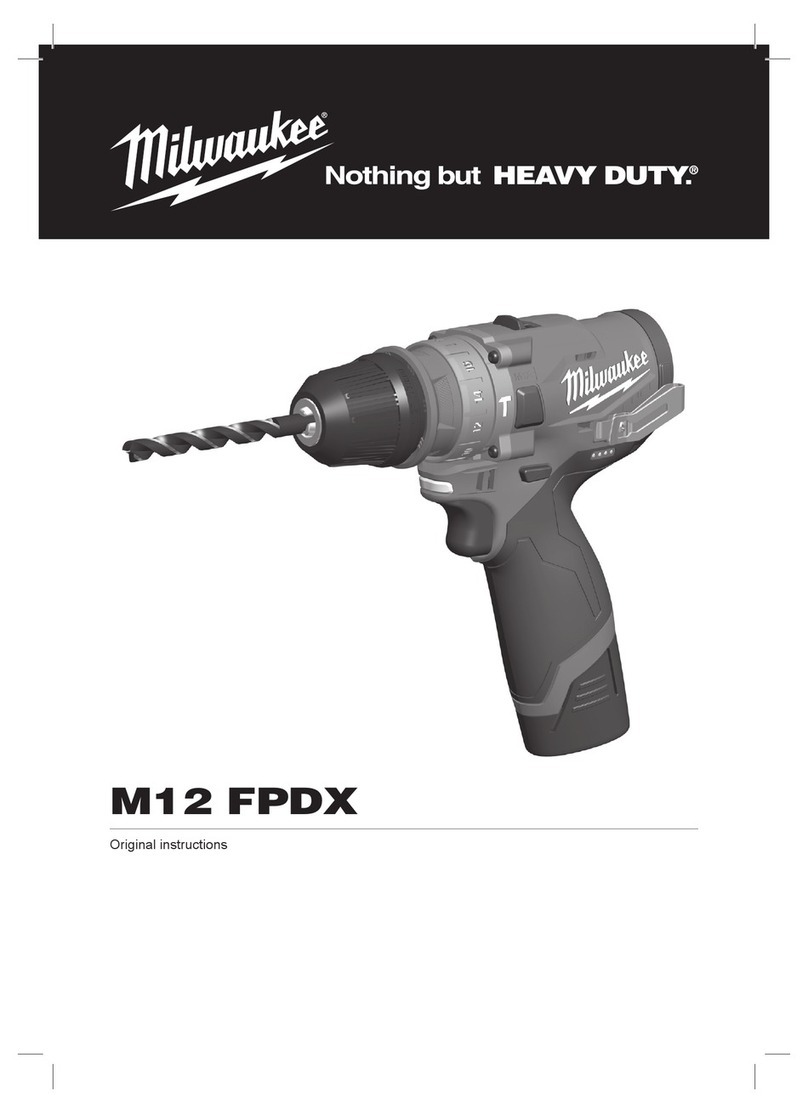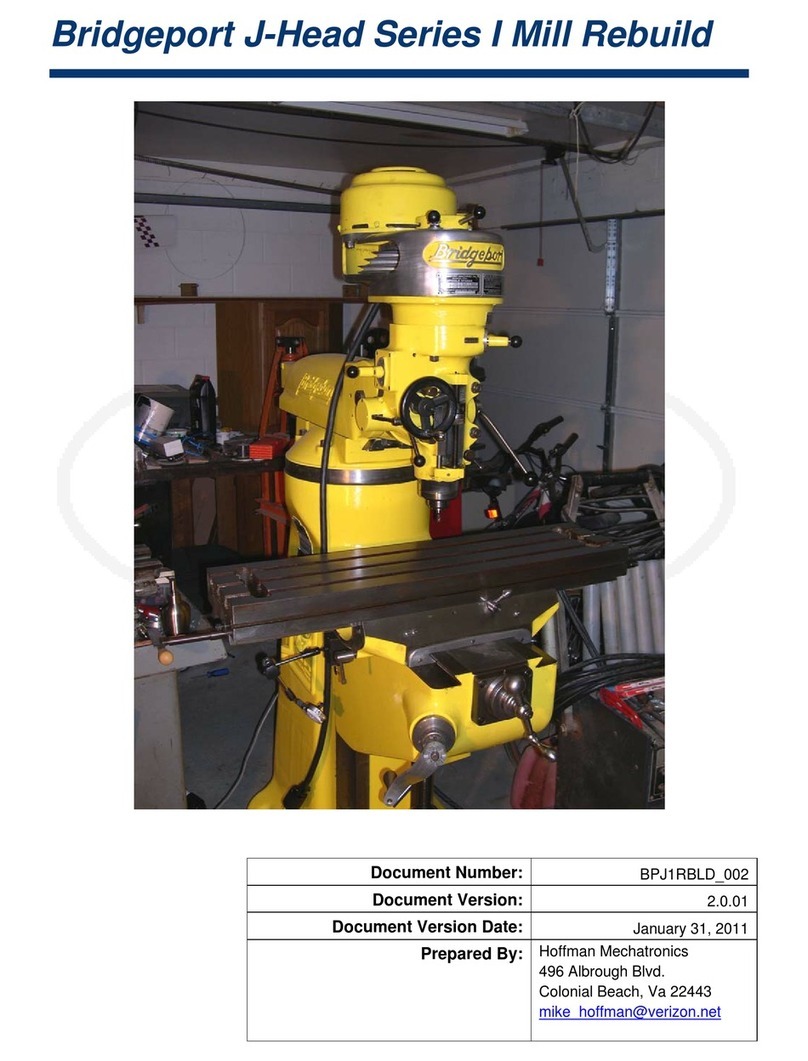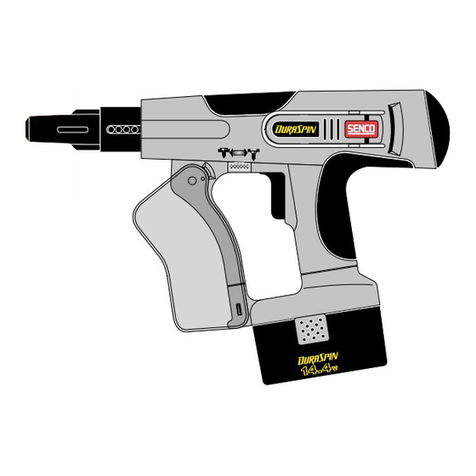Robland Z500 Series User manual

Z500-serie V0818 1
EnglishDeutsch
Index
Important instructions when ordering spare parts 2
Safety and maintenance instructions 2
Danger list 3
Operating instructions 4
Normal and prohibited use 5
Explanation of acoustic levels 6
General dimensions 6
Technische gegevens 7
Transportation and installation of the machine 8
Electrical connection 8
Mounting the sliding table 9
Starting the machine 10
Starting the machine version X1,X3 11
Changing main sawblade and scorer sawblade 20
Use and adjustment of the riving knife 21
Lower sawblade cover 21
Adjusting the main sawblade and scorer sawblade Z500 22
Adjusting the main sawblade and scorer sawblade (Z500EL and Z500X) 22
Blocking the sliding table 23
Mounting of the cross-cut table 24
Mounting of the cross-cut fence 25
Adjusting the cross-cut fence 25
Use of the parallel fence 27
Calibration of the scale on the parallel fence 27
Mounting of the roller support 28
Using the saw guard 28
RPM indicator lights 29
Belt tension and speed changing 30
Belt tension and speed changing scoring saw 30
Maintenance of the machine 31
Problems: causes and solutions 31

2V0818 Z500-serie
English Deutsch
Important instructions when ordering
spare parts
Always mention the following items on your order:
- Type and serial number of the machine
- Serial number from manual
- Part number and quantity
- Your reference and correct delivery address.
VOOR UW EIGEN VEILIGHEID EN DE LEVENSDUUR VAN UW MACHINE: GEBRUIK ENKEL
ORIGINELE ROBLAND ONDERDELEN !!!
Safety and maintenance instructions
The risks associated with using woodworking machinery are high since they use high-speed sharp
cutters to do the job and in many cases these are necessarily exposed to enable the machining
process to take place. Also, because many machines are still hand-fed, woodworking is probably the
main industry where the hands of the operator are constantly exposed to danger.
As well as the high risk of injury from contact with the cutters, there is the risk of being injured by the
ejection of the workpiece or cutters (or parts of them) from the machine. No two pieces of wood are
the same; each piece behaves differently when machined or shaped during the production process.
Knots and natural changes in the direction of the grain can give rise to snatching and kickback of the
workpiece.
Serious risks are related to the use of woodworking machinery, which are sharp, vibrant and noisy
machines. The machine can only be used safely if the operator strictly follows the operating and
safety instructions. It is essential to read this manual before using the machine so you know how to
the machine works and what its limitations are.
Provide sufficient space around the machine and a good lighting of the workshop.
Always make sure that all safety devices are fitted to the machine and that the machine is connected
to a dust extraction system.
Keep dust levels down with good housekeeping. Keep the work area clean so you do not resuspend
dust into the air while working. Never use compressed air to clean the work area or clothing, because
it generates dust. Wood dust is harmful by inhalation and in contact with skin for all woods, but more
or less according to the varieties of types (deciduous, conifers, exotic) and chemicals potentially
associated (including formaldehyde in MDF).
Exposure to wood dust and many chemicals (solvents, adhesives and varnishes...) generate a risk of
allergic reactions, respiratory and sinus cancer.
Use a dust mask and hearing protection when working with the machine. To avoid inhalation of wood
dust many types of masks and filters are available. A good choice and application are important for
proper operation.
Carefully read the instructions for the cleaning of the machine.
Do not remove by hand wood residues to a running engine. Do it only with a fully disabled machine.
When changing tools or when doing a maintenance job, the machine must always be disconnected
from its power supply.
Knives and tools which are not correctly sharpened, or in a bad shape, not only diminish the quality
of the work, but also increase the risk of accidents.
Always wear suitable clothing, loosen or torn clothing is dangerous.
Keep children and non-trained personal away from the machine and out of the workshop.
Always use templates during the machining of special parts.
Be sure to use only blades corresponding to the dimensions indicated in the technical data and

Z500-serie V0818 3
EnglishDeutsch
relevant to your work.
Make sure that periodic maintenance be carried out in due time. Try out weekly the emergency stops.
Read the instructions of maintenance and adjustment of the automatic brake of the motor. Check if
the automatic braking of the motor time is less than 10 seconds, if the emergency stops functioning
correctly.
All guards need to be kept in a good working condition and need to be checked regularly to ensure
that they move freely, are free from any defect and are capable of being adjusted over the full range
of work for which they were designed.
Maintenance work should only be carried out by people who have the combination of training, skills,
experience and knowledge to do the work.
Danger list
This list was based on EN 12100.
Mechanical risks caused by, for example:
- the shape, the mass and the stability (potential energy of the elements), relative disposition,
the mass and speed (kinetic energy of the elements), insufficient mechanical resistance,
accumulation of potential energy of the elastic elements (springs), elements of the machine or
machined pieces
- Risk of crushing
- Risk of cuts
- Risk of gasping, wrapping
- Risk of electric shock or pinching
- Ejection of elements (of the machine or of the processed part), electrical risks, caused by
electrical contact (directly or indirectly)
- Risks caused by noise, materials or inhalation of toxic substances
- Risk of fire or explosion
- Combination of risks
- Risks caused by failure in the supply of energy, defect of elements of the machine and other
functional disorders, for example all types of safety devices, safety equipment and start / stop
equipment.
- Safety signals and pictograms and all types of information or equipment.

4V0818 Z500-serie
English Deutsch
Operating instructions
The following recommendations for safe working procedures are given as an example, on top of all
information characteristic of this machine.
- When working with the machine, safety equipment must be used.
- Nevertheless, the user must also follow the operating instructions to avoid accidents.
1 Training of machine users
It is absolutely essential that the panel saw user receives thorough training regarding operating and
adjusting the machine.
In particular:
a) the risks involved in working with the machine;
b) the operating principles, the correct usage and adjustment of the machine;
c) the correct choice of the tools for each operation;
d) the safe handling of parts to be processed;
e) the position of the hands in relation to the sawblade;
f) storing the workpieces safely before and after sawing them.
2 Stability
In order to be able to use the machine safely, it is essential to place it stably on the ground or other
stable surface.
3 Adjustment and installation
a) Disconnect the machine from the power supply before every adjustment.
b) The recommendations of the manufacturer must be followed when adjusting and installing the
tools.
c) The tools must be suited to the material being cut to assure safe and efficient sawing. The tools
must be correctly sharpened and installed.
4 Handling of tools
In order to avoid severe cuts, safety measures must be taken when handling the sawblades.
5 Intended use of the machine
The machine may only be used for processing all types of wood, panels and sheets with or without
plastic coating. The processing of plastic sheets and plastic is permitted with adapted saws. The
machining of ferrous and non-ferrous metals is strictly forbidden. In order to be able to maintain
the indicated sound values, all protective caps and means provided on the machine must be used.
This also applies to the dust emission and means that the machine must be connected to a dust
extraction system, whose air flow rate measured at the extraction opening on the machine is at least
20 m / sec. amounts.

Z500-serie V0818 5
EnglishDeutsch
Normal and prohibited use
The panel saw is designed for the following work and is equipped with protective devices for these
processes only. It is not designed to work materials such as ferrous or non-ferrous metals, work
different from that stated below is prohibited.
- Ripping with the parallel saw fence with/without the sawblade tilted and the fence upright or in
the low position.
- Right-angled or mitre cuts with the 90° fence mounted to the sliding table with tilted or vertical
sawblade.
- Cross-cutting workpieces using the adjustable stop on the 90° fence.
- Cutting panels or solid wood on the sliding table.
PROHIBITED USE
Following tasks are prohibited on the panel saw :
- submerged cuts by removing the riving knife and/or guard;
- all types of cuts without using the table saw fence, the 90° fence or sliding table;
Cutting large workpieces that exceed the machine capacity without using aids such as roller
supports.
REMAINING RISKS
The most important risks on the panel saw are:
- unintentional contact of the hand with the saw blade;
- contact with the saw blade during the stop time of the saw blade (10 sec).
- recoil of the workpiece or recoil of parts within the workpiece
- tilting of the workpiece due to insufficient support.
- Injuries due to tool breakage or parts that break off the tool.
- Injuries in the non-secured area between the machine table and the saw blade during sawing
parts.
- Risk of pinching and crushing between the parallel fence and the sliding table
- Risk of pinching and crushing between the parallel fence and the saw blade, riving knife and saw
blade.
- When moving the sliding table, there are risks for clamping, pinching and crushing. Only use the
handle to move the sliding table.
- When cutting plastics, there is a risk of the release of harmful substances.
- Risks due to changes made to the machine by unauthorized personnel.
- Risks for the machine, tools and safety equipment when tilting the blade while the saw blade is
rotating.
- Risks for the machine, tools and safety equipment when setting the parallel fence with rotating
saw blade.
SOUND REDUCTION
- The type and condition of the saw blade is important to keep the noise level as low as possible.
- The material and the position of the safety devices are important for reducing the noise level.
Using the correct speed of the saw blade for the type of material will reduce the noise level.
- The above does not mean that no additional protection measures such as hearing protection
should be used.

6V0818 Z500-serie
English Deutsch
Explanation of acoustic levels
The values given are the emission values and not necessarily the safe working levels.
Although there is a relationship between the emission values and the level of exposure, this can not
be reliably used to determine whether additional measures need to be taken.
Measurements according: NBN EN ISO 3746 (2011)
NBN EN ISO 11202 (2010)
Measurements performed by: Vinçotte nv
Workstation Level acoustic load
dB (A)
Level acoustic power
dB (A)
Sawing 92.1 100.1
General dimensions

Z500-serie V0818 7
EnglishDeutsch
Technische gegevens
Voltage 230V / 400V
Motor power 7 kW (S6) option 9,2 kW (S6)
Weight 890 kg (Z500) - 1080 kg (Z500X3 3800)
Saw
Diameter saw and bore 300 - 500 x 30 mm
Cutting depth at 90° / 45° 175 mm / 122 mm
RPM 3000 / 4000 / 5000
Sawblade tilting 90° - 45°
Cutting width parallel fence 1000/1350/1525 mm
Cutting width parallel fence automatic 1250/1500 mm
Cutting length 3200 (option 2500, 3800) mm
dimensions cast iron table 985 x 710 mm
dimensions sliding table 3200 x 420 (option 2200, 3800) mm
dimensions cross-cut table 1505 x 7600 mm
Length of cross-cut fence 2295 (telescopic 3355 mm)
Scoring unit
Diameter saw blade and bore 120 x 20 mm
cutting depth with 120 mm diameter blade 3,5 mm
RPM 8200
scoring saw motor power 1,3 kW (S6)
Features
Diameter aspiration tubes 120 + 100 mm
Motorized rise and fall of the saw Z500 EL, X1
Motorised tilting of saw aggregate Z500 EL, X1
Motorised and programmable parallel fence Z500 X1, X3
Numerically controlled height and tilt of saw Z500 X3
Mitre fence on sliding table option
Extra support table with rip fence option
Eccentric clamp option
Double sided mitre fence option
Automatic star-delta start standard
Digital read out on both ippers of cross cut fence option
Digital read out of tilt of the saw aggregate option Z500 EL
Digital read out of height of saw blade option Z500 EL
Digital read out on parallel fence option Z500 (EL)
Support roller option

8V0818 Z500-serie
English Deutsch
Transportation and installation of the
machine (Fig.1-2)
Depending on the transport or shipping method you will receive the machine either in a box or not
packaged. The packaging itself, made of sturdy fibre boards and the wooden beams, can easily
be reused. You can lift the machine with a crane or forklift truck and bring it to the ground. On the
front of the frame there are two openings with which you can move the machine with a hand pallet
truck. (2)
Ensure that the machine is well balanced in the lifting belts when moving. Secure the belts against
lateral shearing.
ATTENTION:
Always check if the payload of your hoist is large enough.
After unpacking, check that the machine has not been damaged during transport or during unloading.
Place the machine stably on a solid surface and provide sufficient space around the machine to work
in a safe manner. The machine must be levelled in both directions. There are 6 adjusting bolts on the
machine, see fig.2
Fig.1 Fig.2
Electrical connection (Fig.3)
The electrical connection must be carried out by a qualified electrician who is able to calculate
exactly the required wire cross-section and capacity of the workshop fuses.
Check that the main voltage of the machine corresponds with the voltage supply to your workshop.
Now open the electrical switch panel and introduce the cable. Connect the 3 phases to the
terminals on the connection block marked L1, L2, L3. If there is a neutral conductor (blue) it must be
connected to the terminal N.
Connect the earth wire (green-yellow) to the terminal marked with the earth symbol PE.
ATTENTION :
- Check first if the saw spindle runs freely and if all safety devices are fitted before starting the
machine.
- If the direction of rotation of the sawblade is not correct, the wires L1 and L2 must be exchanged
(clockwise direction of the spindle is correct).
- For safety reasons this must only be done without the sawblade on the spindle !
THERMAL OVERLOADS
The machine has overload protections on both saw and scoring motors. Should the motor be shut-off
by one of these protectors, it is necessary to wait a few minutes until the overload has cooled down.

Z500-serie V0818 9
EnglishDeutsch
Mounting the sliding table (Fig.4)
To obtain a good arrangement and function of the sliding table; it is vital that the machine is put on a
right level in both directions, with the help of a level, before putting the sliding table on the machine.
All the adjustments and arrangements are done in the factory. Simply put the table onto the frame
with the two lateral adjustment bolts (1) into the two lugs of the frame. Be sure that the girder rests
well in the height adjustment bolts. Now place the 4 big Allen bolts (3) and tighten well. In order to
obtain a good movement of the wood or the sliding table, the sliding table is set near to 2 mm above
the sawing table. The parallelism between the principal blade and the sliding table, can be corrected
by using 2 bolts. After the adjustment, the 4 bolts need to be tightened well with a Torque wrench
with a value of 7 kg (70 Nm). The adjustment in height of the sliding table can be done by using 8
bolts (2) but always with the big bolts closed.
Fig.3
Fig.4 Fig.6

10 V0818 Z500-serie
English Deutsch
Starting the machine (Fig.5-6)
Set main switch (1) to “1” to energize the machine (fig. 6.1).
For model Z500 fig (5A) and model Z500 EL fig (5B), for model Z500 X1 fig (5C) and Z500 X3, fig (5D).
Start the main engine (white button) and stop (black button) with the button (3).
The scorer motor is started by pushing the button (4); this is only possible with the main saw motor
running.
The upper white button starts the engine, the lower black button stops the engine.
When the emergency stop (1) is pressed, both motors are switched off. The main saw motor is
equipped with an automatic brake which slows down the motor within 10 seconds as soon as the
machine is shut off.
ATTENTION:
When the machine access door is open, the saw blade cover is open, or one of the emergency
stops is pushed in, the machine cannot be started.
If a saw blade> 350 mm diameter is mounted, the scoring blade must be disassembled.
ATTENTION! Also the flange where the scoring blade is mounted must be removed, if it does
not, it can come loose and cause serious injuries, or damage the saw blade, which can also
cause serious injuries.
By means of the lights (2) the set speed can be read before starting (only for CE version).
All fuses are located inside the electrical panel and each time this panel is opened the machine
has to be disconnected from its power supply.
Fig.5A Fig.5B
Fig.5C Fig.5D

Z500-serie V0818 11
EnglishDeutsch
Starting the machine version X1,X3
1. STARTING UP THE MACHINE
Startscreen
Turn the mains on-off switch to “ON”
After the start procedure is completed this screen
will appear.
Now push the start button in order to start the
reference procedure.
All 3 axis will now start moving to their reference
points.
In order to speed-up this procedure, it is best to use
the “Park” function at the end of the working day.
(s ee 2.2)
During reference procedure you will see this screen.
As soon as one axis has reached the reference
point an “V” will occur.
As soon as all 3 axis have reached their reference
point, the main screen will appear.
Park function
Menu functions
Selection of the axis
Information about time, diameter of the saw blade in function on the machine and R.P.M of the saw blade.
Main screen

12 V0818 Z500-serie
English Deutsch
2.1 SETTING AN AXIS
Select an axis by pushing a field.
The frame of the button lights up in fat as
confirmation this button has been selected.
Each axis has a selection screen.
After confirming you get the main screen.
Now you will see an arrow appear and the start button starts flashing. The axis starts moving as soon
as the start button is pushed. The values of one or more axis can be adjusted at the same time.
value
max. value
Selected axis
Return
Conrm
min. value
The selection screen has a calculator function
On the left side you see
the list of the 4 last used
values
Selection screen
Desired value
Current value

Z500-serie V0818 13
EnglishDeutsch
2.2 PARK POSITION
This function enables the quick start-up and reference procedure of the machine.
You get the choice between only parallel fence park position or all 3 axis.
3.1 MENU SCREEN
Park button
Only park parallel fence
Park all 3 axis
MENU button

14 V0818 Z500-serie
English Deutsch
3.1.1 SETTING SAW BLADE
First a warning screen appears.
The fence will be moved away from the saw blade,
set the saw blade at 90° and at its maximum height.
You can pre-program 4 saw blades.
By selecting the field you can select the saw blade.
By pushing the value field under diameter, B or b
you can change the value.
When, after sharpening the saw blade, these values have changed, you can adapt these values. The
machine will also correct the cutting depth.
The difference between the saw tooth (B) and the main saw blade body (b) is important for
compensating the parallel fence.
Setting groove cutter
Setting saw blade
Settings
Height calibration
Cutting lists
Tilting parallel fence
Calibration parallel fence
Menu screen

Z500-serie V0818 15
EnglishDeutsch
After confirming your choise of the saw blade, you
will be asked an extra control of the R.P.M.
The machine shows the current R.P.M., you must
confirm this is the right speed for this saw blade.
3.1.2 SETTING THE GROOVE CUTTER
This procedure is the same as for changing the saw blade. The differences are:
The table insert has to be taken away in order to mount the groove cutter tool.
The maximum dimensions of this tool is 16 mm wide and a body thickness of 12 mm.
1 groove cutter can be stored the same way as a
saw blade.
Once the groove cutter selected, the whole saw unit
can only be moved up-and down. It is impossible to
groove at an angle.
The high lighted symbol indicates which value you change,
in this case the saw blade diameter
Min. and max. value
of the saw blade
Numeric eld
Return
Conrm
Screen saw blade settings

16 V0818 Z500-serie
English Deutsch
3.1.3 CUTTING LISTS
By pushing the field after the number, each cutting
list can be given a name.
By selecting the number, you can enter the screen cutting list.
There are 100 x 5 cuting lists
Possiblity to name each cutting list
Remove
Return
Conrm
Menu screen cuting lists
Go to next or
previous cuting list
Return
Conrm
Selected cuting list
To change the value, push the value.
Changes are made in the setting a measurement screen (see 2.1)
Screen cutting list

Z500-serie V0818 17
EnglishDeutsch
3.1.4 SETTINGS
3.1.4.1 LANGUAGE CHOISE
Choose language and confirm.
3.1.4.2 SETTINGS OF TIME AND DATE
First select the field
Choose day, date, … with arrows < and >.
Change the value with the arrows up-and down.
Confirm in order to store the value.
3.1.4.3 SELECT WORKING IN MM OR INCH
Select the wanted system and confirm in order to
store.
Settings of time and date Setup
Open or close motor brake
Return
Selection
MM or Inch
Language menu

18 V0818 Z500-serie
English Deutsch
3.1.5 CALIBRATION OF PARALLEL FENCE
Select the parallel fence on the display and
enter 100mm.
Saw a piece of wood and measure it. For instance:
99,31mm.
Choose “MENU”. Press the symbol bottom left.
Conrm to register.
Enter code: 9876
Press the symbol bottom left again to go to the
next screen.

Z500-serie V0818 19
EnglishDeutsch
Replace the value on the display by the mesured
value - for instance. 99,3 – and conrm the
corrected value.
Press the symbool to move the parallel fence to
the corrected value.
Saw another piece of wood and check the
measured value.

20 V0818 Z500-serie
English Deutsch
Changing main sawblade and scorer
sawblade (Fig.8-9)
Warning: Before changing sawblades always turn off the main switch.
Handle sawblades with care, to avoid serious cuts and injuries.
Push the sliding table to the rear and open the saw cover. Raise the main sawblade to its highest
position and put the key(2) into the saw spindle nut.
Put the locking pin in the opening of the saw table and turn the spindle with the key (3) until the
locking pin (2) engages in the hole in the saw spindle pulley.
Now unlock the nut (1). Before fitting the new sawblade ensure the blade and flanges are clean. This
prevents wobbling of the sawblade.
Never forget, after the saw spindle nut has been tightened, to remove the locking pin from the pulley
before starting up the motor.
ATTENTION:
Only saw blades with a diameter of 300 to 500 mm may be placed on the machine.
PAY ATTENTION! For saw blades larger than 350 mm, the scoring blade and the flange of the
scoring blade must be removed!
The use of HSS saw blades is strongly prohibited, as well as the use of deformed or cracked saw
blades. Only use saw blades in carbide!
Also make sure that the saw blades are always sharp and cut according to the manufacturer’s
specifications.
The scoring unit blade can be changed as follows; Turn the scoring blade to the left and place the
supplied key (1) on the flattened spindle. Then unscrew the tensioning bolt (right-hand thread) with
the hexagonal wrench (2). After tightening, tighten the central tensioning bolt correctly.
WARNING:
All main sawblades which are used on the panel saw must have two additional holes in the sawblade
body, to prevent the sawblade from loosening when the rotation of the saw spindle is stopped by the
brake on the motor.
The two little bolts in the fixed saw spindle flange prevent the saw from coming off and may under no
circumstance be removed.
The dimensions of these holes can be seen in fig. 11
Fig.8 Fig.9
This manual suits for next models
4
Table of contents
Languages:
Other Robland Power Tools manuals
Popular Power Tools manuals by other brands
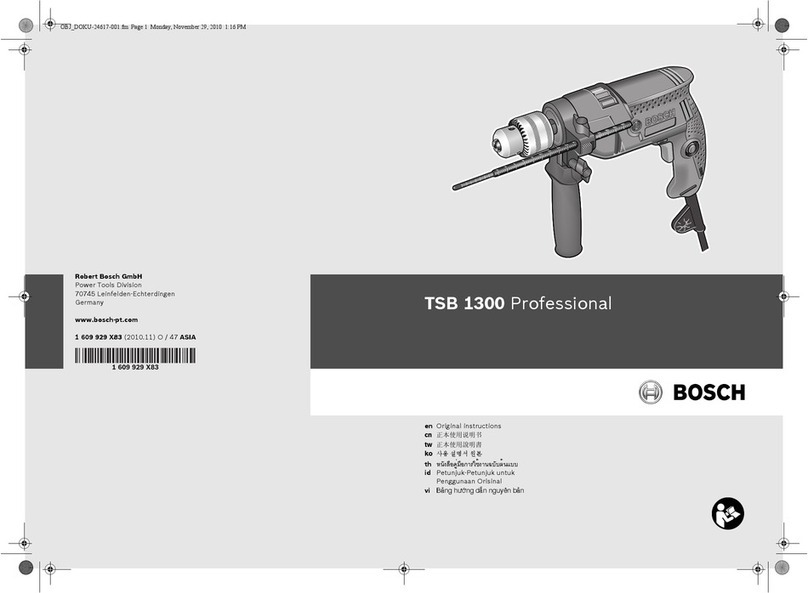
Bosch
Bosch TSB 1300 professional instruction manual

Chicago Pneumatic
Chicago Pneumatic CP7828 Operator's manual
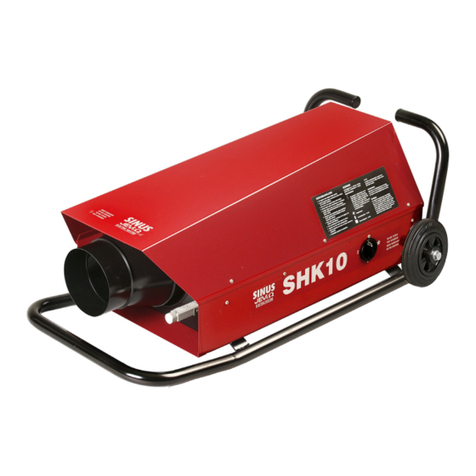
Sinus Jevi
Sinus Jevi SHK 10 instruction manual
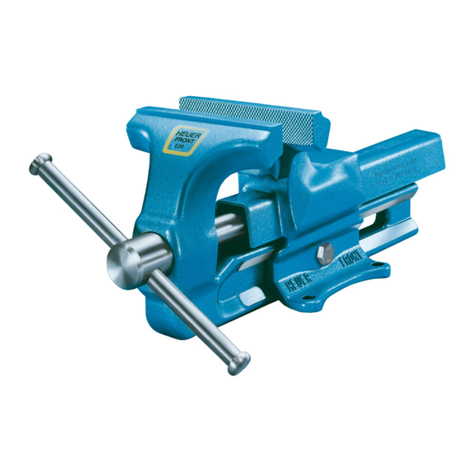
Brockhaus Heuer
Brockhaus Heuer 100 Assembly and maintenance instructions
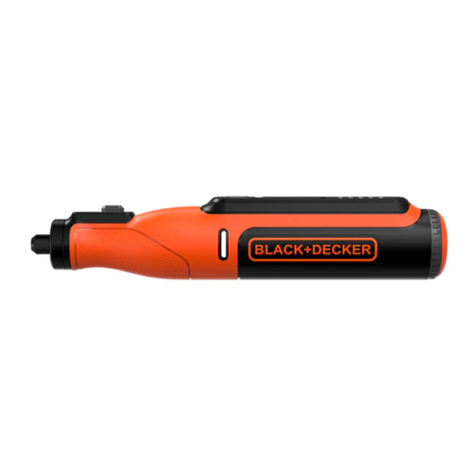
Black & Decker
Black & Decker BCRT8K instruction manual

Stanley
Stanley DH1500 user manual
